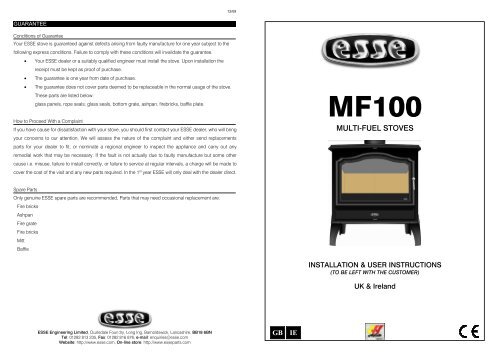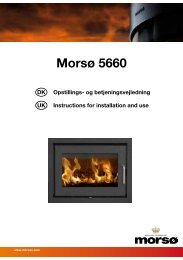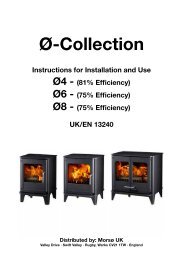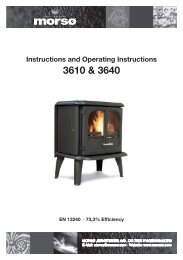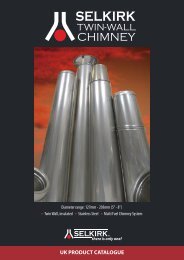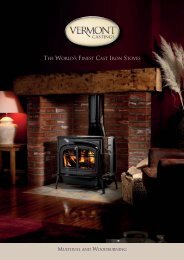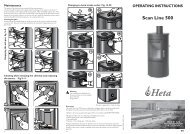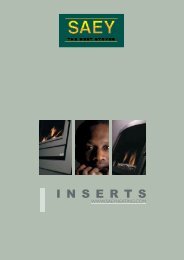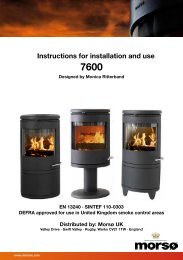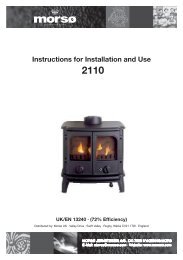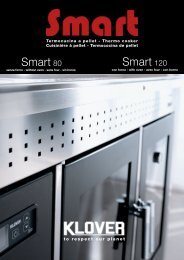MF100 - Esse
MF100 - Esse
MF100 - Esse
You also want an ePaper? Increase the reach of your titles
YUMPU automatically turns print PDFs into web optimized ePapers that Google loves.
12/09GUARANTEEConditions of GuaranteeYour ESSE stove is guaranteed against defects arising from faulty manufacture for one year subject to thefollowing express conditions. Failure to comply with these conditions will invalidate the guarantee.• Your ESSE dealer or a suitably qualified engineer must install the stove. Upon installation thereceipt must be kept as proof of purchase.• The guarantee is one year from date of purchase.• The guarantee does not cover parts deemed to be replaceable in the normal usage of the stove.These parts are listed below:glass panels, rope seals, glass seals, bottom grate, ashpan, firebricks, baffle plate.How to Proceed With a ComplaintIf you have cause for dissatisfaction with your stove, you should first contact your ESSE dealer, who will bringyour concerns to our attention, We will assess the nature of the complaint and either send replacementsparts for your dealer to fit, or nominate a regional engineer to inspect the appliance and carry out anyremedial work that may be necessary. If the fault is not actually due to faulty manufacture but some othercause i.e. misuse, failure to install correctly, or failure to service at regular intervals, a charge will be made tocover the cost of the visit and any new parts required. In the 1 st year ESSE will only deal with the dealer direct.<strong>MF100</strong>MULTI-FUEL STOVESSpare PartsOnly genuine ESSE spare parts are recommended, Parts that may need occasional replacement are:Fire bricksAshpanFire grateFire bricksMittBaffleINSTALLATION & USER INSTRUCTIONS(TO BE LEFT WITH THE CUSTOMER)UK & IrelandESSE Engineering Limited, Ouzledale Foundry, Long Ing, Barnoldswick, Lancashire, BB18 6BNTel: 01282 813 235, Fax: 01282 816 876, e-mail: enquiries@esse.comWebsite: http://www.esse.com, On-line store: http://www.esseparts.com12GB IE1
CONTENTSGeneral Safety Notes Page 2 Operating Instructions Page 8Chimney & Flue Page 3 Wood Burning Page 8Flue Draught Page 5 Solid Mineral Fuel Burning Page 10Dimensions & Clearances Page 6 Maintenance Page 11These instructions give a guide for the installation of the appliance but in no way absolves the installer fromresponsibilities to confirm to British Standards, in particular BS8303and BS6461, relating to the installation ofsolid fuel appliances. All local regulations, including those referring to National and European standardsneed to be complied with when installing the appliance.Parts of the appliance, especially the external surfaces, will be hot to touch when inoperation and due care will need to be taken.Installing the Stove Page 6 Guarantee Page 12GENERAL SAFETY NOTES• Properly installed, operated and maintained, this appliance will not emit fumes into the dwelling.However occasional fumes from de-ashing and re-fuelling may occur. Persistent fumes emission ispotentially dangerous and must not be tolerated. If fume emission does persist, open doors andwindows to ventilate the room. Let the fire burn out or eject and safely dispose of fuel from theappliance. Once the fire is cold, check the flue and chimney for blockages and clean if required. Donot attempt to relight the fire until the cause of the fume emission has been identified and corrected.Seek expert advice if necessary.• Do not fit an extractor fan in the same room as the appliance.• An adequate air supply for combustion and ventilation is required. As this stove does not exceed 5.0kW nominal heat output (Refer to Building Regulations Document J) a purpose provided air vent is notnormally required. However, in certain circumstances a purpose provided air vent may be necessary –for example, small or tightly sealed rooms. Air openings provided for this purpose must not berestricted.• It is important that flue ways are cleaned frequently and the chimney swept regularly. Also the stovemust be maintained in good mechanical order. The chimney should be swept at least once per yearfor smokeless fuel and a minimum of twice per year for other fuels.• If the chimney was previously used for an open fire, it is possible that the higher flue gas temperaturesgenerated by the stove may loosen deposits that were firmly adhering to the inner surface of thechimney and cause blockage of the fluepipe. We recommend that in such a situation a secondsweeping of the chimney should be carried out within one month of regular use of the stove afterinstallation. Also, lock open or remove any existing dampers in the flueway.• Should it be likely that children, aged or infirm people approach the fire, then a fireguard should befitted.• Avoid the use of aerosol sprays in the vicinity of the stove when it is in operation.• This appliance must be installed as per these instructions and regulations complied with. Nomodifications or alterations of any kind are permitted.INSTALLATION INSTRUCTIONSThe installer has a responsibility under the Health and Safety at Work Act 1974 to provide for the safety ofpersons carrying out the installation. Attention is drawn to the fact that fire cement is caustic and hands mustbe washed thoroughly after use. The appliance is heavy and care must be taken during handling. Althoughthe appliance does not contain asbestos products, it is possible that asbestos may be disturbed in existinginstallations and every precaution must be taken.2CHIMNEY & FLUEYour stove should be used as an incinerator and only recommended fuels shall be used.The successful operation of these appliances relies on the adequate performance of the chimney to which itis connected. The chimney must:• Have an internal cross section of no less than 320cm 2 (200mm dia). If a flue liner is used it should be5'' diameter (125mm) and suitable for solid fuel.• Be a minimum 4.6m high from hearth level to pot.• Be terminated at least 1m above roof level so that the chimney does not terminate in a pressure zone(see Fig.2).• Be free from cracks, severe bends, voids and obstructions.• Be connected to this one appliance only.• New chimneys must be built in accordance with local building regulations.• New chimneys must be tested in accordance with HETAS requirements.• If this stove is installed as a freestanding appliance, it should not support any part of the chimney.• Voids in the chimney should be avoided, as these will prevent a steady flue draught.• The stove flue pipe should pass beyond the narrowing of the chimney (see Fig. 1).• Consideration should be given to falling soot. For rear outlet stoves it may be necessary to provide asoot catchment area in the flue pipe so that soot does not settle in the path of the flue gases. Theoptional rear flue box attachment available from ESSE has a detachable base that allows for fallensoot to be removed (See Fig.1).• A flue/chimney access point may also be required so that the state of the chimney can be checkedand any fallen soot removed.• External flues must be insulated to prevent heat loss.3
Fig. 1 – Ideal Flue Connections.FLUE DRAUGHTThe chimney can be checked, before the stove is installed, with a smoke pellet. If the chimney doesn’t pullthe smoke it may suggest the chimney needs attention (see the Flue Diagnosis Table, below).MeasurementsThe flue draught test hole must be drilled in the flue pipe as close to the stove as possible and before anyflue draught stabiliser.This test is only a guide as an apparently poor flue may improve once the stove isinstalled, lit and the flue is warmed. If, once the stove is installed, there is any doubt thatthe chimney is providing an adequate draught, a flue draught reading can be taken withthe stove lit. Two flue draught readings should be taken, one with the stove at minimumfiring rate and one at maximum firing rate.MinimumThe stove should be lit and allowed to warm the flue thoroughly. The air controls can then be set so that thestove burns on a low setting. Allow the burning rate to become steady. The flue draught reading should nowbe taken with the primary air intake closed and the airwash control fully open.Fig.2 – Chimney and Flue PerformanceMaximumThe primary air intake can now be opened to allow the stove to burn at maximum rate. Give the stove sometime for the burning rate to become steady and then close the primary air intake, make sure the airwashcontrol is fully open and take a flue draught reading immediately.Ideally, the flue draught reading should range between 1mm wg (10 Pa) and 2.5mm wg (25 Pa). Anyreadings significantly outside this range may indicate the need for remedial action.Low flue draught symptoms: difficult to light and smoke coming into the room.CAUSECold chimneyChimney too shortDown draughtChimney diameter too largeChimney obstructionRestricted air supplyREMEDYLine the chimneyExtend the chimneyRelocate/extend chimney terminal. Fit an anti down draught cowlLine the chimneyClear/sweep the chimneyCheck for competing draughts (other chimneys, extractor hoods/fans).Fit an air vent if the room Is sealed.High flue draught symptoms: fire difficult to control, fuel will not last, stove too hot, stove damage, chimney fire.CAUSEExternal wind conditionscombined with chimney terminalREMEDYFit stabiliser cowl.Fit flue draught stabiliser.45
FLUE STABILISERA flue stabiliser can be fitted to reduce the draught through the stove if the flue draught is too high. The fluestabiliser should be:• Fitted in the same room as the stoveHearthThe construction of the hearth must conform to Building Regulations, must be firm, non-combustible andcapable of supporting the stove. (Refer to Building Regulations Document J). The stove has beenindependently certified as suitable to stand on a 12cm (½'') thick non-combustible hearth.• The same size as the flue pipe• Fitted no closer than 700mm to the flue outlet of the appliance.Fig. 4 – Arranging the flue plug for top or rear outletFig. 6 – Anthracite PlatesDIMENSIONS & CLEARANCESFig. 3 Stove DimensionsFig. 5 – Using the stove mittINSTALLING THE STOVEPositioningThe overall dimensions of the stove are shown in Fig. 3. The table above indicates recommended distancesbetween the stove and surrounding combustible materials. As a rule, any surrounding combustible materialshould not exceed 80 ºC. There should be sufficient space around the stove for service work.67
` Flue ConnectionThe flue pipe used to connect the stove to the chimney is 5'' (125mm) in diameter. The stove is suppliedready for top flue connection. To change to rear connection the flue blanking plug supplied with the stove isused to block the top flue outlet. The blanking plug in the rear flue connection must then be removed (toaccess the bolts attaching the rear flue connection the convector panel must first be removed) – see Fig.4. Arear flue box attachment is also available from ESSE that allows the stove to be installed further out of anybuilding recess. Fig.1 shows suitable flue connections.Important Installation Notes1. The installation must allow for adequate chimney sweeping.2. Avoid using bends greater than 45 ºC to the vertical. All flue pipe sections should be as close tovertical as possible.3. All joints in the flue system must be effectively sealed.4. All flue sockets must face upwards.5. Check the appliance for soundness of seals between castings and main components and that allsupplied parts and fitting are correctly fitted.On completing the installation, check that all the internal components of the stove are positioned correctly.Check – ashpan, iron grate, baffle, side and back bricks.OPERATING INSTRUCTIONSYour StoveFig. 5 shows stove and its controls.Additional loose parts supplied inside your stove include:• A stove mitt – for removing the ash pan, adjusting the primary air controls, adjusting the airwashcontrol, and operating the door handle. Fig.5 shows how the stove mitt is used.• A flue blanking plug to blank the top flue outlet if the rear flue outlet is to be used.WOOD BURNINGLighting and Controlling the StoveBefore lightning the fire for the first time ensure that the baffle, side and back bricks and all the internalcomponents are in position. Burning without either will result in the stove overheating and being damaged.Open the air wash control and the primary air control fully. Place some tightly rolled paper on top of somecrumpled paper on the base towards the back of the stove. On top of this, place some small pieces of wood.Light the crumpled paper and close the door. Once the fire becomes established add some larger pieces ofwood. As the stove comes up to temperature close the primary air control using the stove mitt as shown inFig.5. The burning rate of the stove can now be regulated by the rate at which fuel is added and by adjustingthe air wash control.With the above in mind it is plain to see that the stove should ideally be run with the primary air inlet closedand the air wash control open whenever possible. Another advantage of running the stove with the air washopen is that the air is being drawn into the stove travels across the glass forming an air barrier between theglass and the fire bed helping to prevent smoke particle sticking to the glass.8If the fire dies down too low, opening the primary air control for a short period will revive it. When reviving alow fire it is important to also use kindling before adding larger logs to help prevent smoke.Ash RemovalOnly remove small amounts of ash from the firebox. When de-ashing, leave 30-40mm depth of ash in thebottom of the firebox for the best performance. Always use the stove mitt to open and close the door.Correct Running Temperature for BurningTo get the best results from your stove it is recommended that a wood stove thermometer (available fromyour stove dealer) be fitted to the flue pipe above the stove, at eye level if possible. The figures below showthe recommended temperature of the flue gases:115ºC – 245ºC (240ºF - 475ºF)The flue gases should be in this temperature band for the safest, most efficient and most economicaloperation of your stove.Below 115ºCThis is below the condensation point of wood gases and may cause the build up of tar in the chimney, dirtythe stove glass and result in the inefficient burning of fuel.Above 245ºCToo hot. Heat will be wasted up the chimney. Excess heat may damage the stove or ignite any existingaccumulation of tar resulting in a chimney fire.Extended BurningWood burns efficiently when the air for combustion is supplied from above the fire bedrather than below. The air supplied above the fire bed provides the oxygen necessary forthe volatile gases (smoke), given off by the wood as it heats to combust. This ensures thatthe gases are burnt and used to heat the stove instead of being wasted up the chimney orcondensating and forming tarry deposits inside the stove, in the flue or on the stove glass.Running the stove with the primary air control open and the air wash control closed willprovide oxygen for the wood to burn on the fire bed but woll not provide air for the volatilegases above the fire bed to combust resulting in a smoky inefficient fire.Loading a large amount of wood into the stove all at once will reduce the temperature inside the stove. If thetemperature is too low, the gases given off from the wood will be too low to combust resulting in a lot ofsmoke covering the inside of the stove, including the glass, with soot. To combat this problem it is a goodidea to increase the temperature of the stove before loading by further opening the air inlets. Load the woodand leave the air controls open until the moisture is driven out of the wood and the stove is back up to anefficient operating temperature. The air inlets can then be reduced to the hold the temperature of the stove.Loading the stove little and often will help keep the stove temperature steady. When loading wood, makesure that the end grain of the wood in the stove is pointing away from the glass, otherwise the moisture andgases coming from the end grain of the wood will dirty the glass.Types of Wood for FuelFor best results use well seasoned hardwood such as Oak, Ash, or Beech. Allow wood to dry out undercover in well-ventilated conditions for at least twelve months. As a rough guide wood is ready for burningwhen radial cracks appear in the end of the logs. Properly dry wood means it should have a moisture content9
of less than 20% which can only be accurately measured using a moisture meter. Burning wood that is notseasoned will result in tar being deposited in the stove, on the glass and in the flueways. This build up of taris a hazard and if it ignites may cause a chimney fire. Resinous softwood burns well and gives a high outputfor short periods but is not as efficient and does not last as long as hardwood.PeatPeat is a fuel conveniently available in some areas and should be burned in the same manner as wood.SOLID MINERAL FUEL BURNINGFit the 2 solid fuel burning plates to each side of the fuel grate as shown in Fig.6.Lighting and Controlling the FireBefore lighting the fire for the first time ensure that the baffle, and the side and back bricks are in position.Burning without either will result in the stove castings overheating and being damaged.Open the air wash control and the primary air control fully. Place some tightly rolled paper on top of somecrumpled paper on the base towards the back of the stove. On top of this, place some small pieces of woodand on top of that a few small pieces of mineral fuel. Light the crumpled paper and close the door. Once thefire becomes established and the fuel is burning, more fuel can be added. When the stove is hot and the fuelis no longer producing smoke, the air wash control can be reduced. The burning rate of the fire can now becontrolled with bottom air slider. As air from the spinner flows up through the grate it will cool the grate barspreventing them from overheating and becoming damaged. Reducing the air inlet and introducing air onlyfrom the air wash will allow the fuel to burn but the grate will not be cooled resulting in damage to the gratebars. When controlling the fire, the air inlet should be altered gradually. Reducing the primary air dramaticallyand all at once on a hot stove will cause the fuel to clinker and will result in a build up of gases and smokewhich could ignite with a bang the moment air is reintroduced.Extended BurningBefore adding a large amount of fuel, the grate should be de-ashed and the ash pan emptied. Add the fuelsloping it from the front coal bar up to the back of the stove to the level of the top of the back brick. Open theprimary air inlet and let the fire burn for a period on high rate in order to hit the stove back up to temperatureand drive off the moisture and gases in the fuel. If a lot of smoke is produced on reloading, the air washcontrol can be opened further to keep the smoke back from the glass. As the fire gets back up to thetemperature, reduce the air wash control and reduce the primary air inlet to suit the burning rate. The exactsetting of the air controls depends on a number of variables including: the flue draught, the fuel used and theinstallation and so the best setting for your stove can only be learned by experience.Ash RemovalThe above text should be used as a guide only. The ideal operation of your stove dependson a number of factors, which vary with each installation, and so gaining experienceoperating your stove is the only way to learn its best operation.The level of ash should not be allowed to build up to the level of the grate. If the level of ash becomes toohigh the air through the grate will become restricted causing the grate bars to overheat and preventing thefuel from burning efficiently.Grate BarsThe grate bars in the centre of the stove will wear more quickly than the ones at the edges. To ensure evenwear, swap the positions of the grate bars occasionally.Mineral FuelsOrdinary bituminous house coal is not recommended and must not be burned in smoke control areas.Burning bituminous house coal will result in a sooty stove and chimney, and the stove glass will requirecleaning regularly. There are numerous natural anthracites and manufactured smokeless fuels that will burncleanly and have more reliable burning characteristics. A list of these fuels and their suitability is produced byHETAS (www.hetas.co.uk). Consult your local fuel merchant to find out what is available in your area. Petrocokeshould not be used as it burns very hot and may damage the stove casting.MAINTENANCECleaning the StoveThe stove should only be cleaned when it is cold. The exterior can be dusted with a firm brush. Do not use acloth, as this will drag on the paint finish leaving lint on the surface. From time to time it may be necessary torenovate the exterior by repainting. High temperature stove paints in aerosol form are available from yourstove dealer. Do not use this form of paint until the stove is cold and always read the instructions on thecontainer before starting to paint. The door glass is made of a special heat resisting ceramic and may becleaned when cold with proprietary glass cleaning liquids and a dry cloth.Shutting Down the Stove (Long Term)The following procedure should be followed if the stove is not to be used for a long period, summertime forinstance. Remove all the ashes from the grate and ash pan and use a vacuum cleaner nozzle to clean ashfrom the base of the stove. Remove the baffle plate and brush the flue ways. Close the door and open the airinlets fully. This action will allow air circulation through the flue ways and help to avoid corrosion andcondensation.ServicingRegular maintenance should be carried out by a competent engineer.TECHNICAL INFORMATIONNormal heat output – woodNominal heat output – solid mineral fuelWeight of stoveMinimum chimney draught5.0 kW4.5kW83.6 kg10 PaMean flue gas temperature – wood 244 ºCMean flue gas temperature – solid mineral fuel 235 ºCFlue gas mass flow - woodFlue gas mass flow – solid mineral fuelThis appliance is not suitable for installation in a shared flue system.3.1 g/s3.6 g/s1011


